Public Health Nutrition: Menu Kilojoule Labeling on Fast Food
VerifiedAdded on 2023/04/21
|8
|1751
|420
Report
AI Summary
This report, prepared by a student, examines the public health nutrition approach of menu kilojoule labeling on fast food menus in Australia. Part A recommends mandatory kilojoule labeling on fast food menus across all Australian states, highlighting its potential to reduce energy intake and combat obesity. The justification includes evidence of effectiveness, equity, acceptability, and feasibility. Part B provides a critical appraisal of two supporting studies: one experimental study examining the impact of different menu labeling types on consumer choices, and another analyzing the accessibility and availability of nutrition information in fast food outlets post-menu labeling legislation. The report concludes that mandatory kilojoule labeling is a sustainable intervention with strong public support, capable of reducing the adverse impacts of obesity, particularly in low socio-economic groups. The report is available on Desklib, a platform offering AI-based study tools and resources for students.
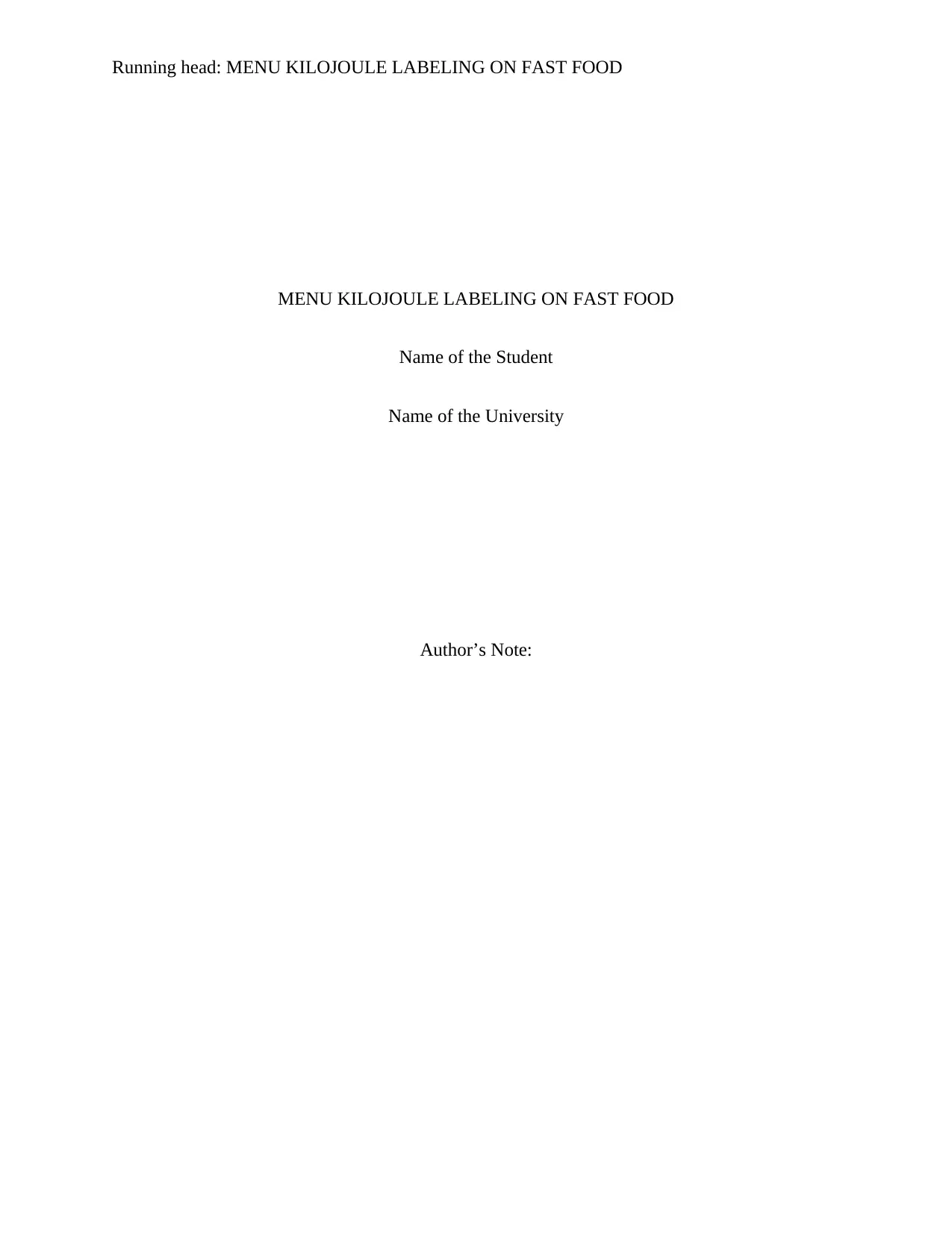
Running head: MENU KILOJOULE LABELING ON FAST FOOD
MENU KILOJOULE LABELING ON FAST FOOD
Name of the Student
Name of the University
Author’s Note:
MENU KILOJOULE LABELING ON FAST FOOD
Name of the Student
Name of the University
Author’s Note:
Paraphrase This Document
Need a fresh take? Get an instant paraphrase of this document with our AI Paraphraser
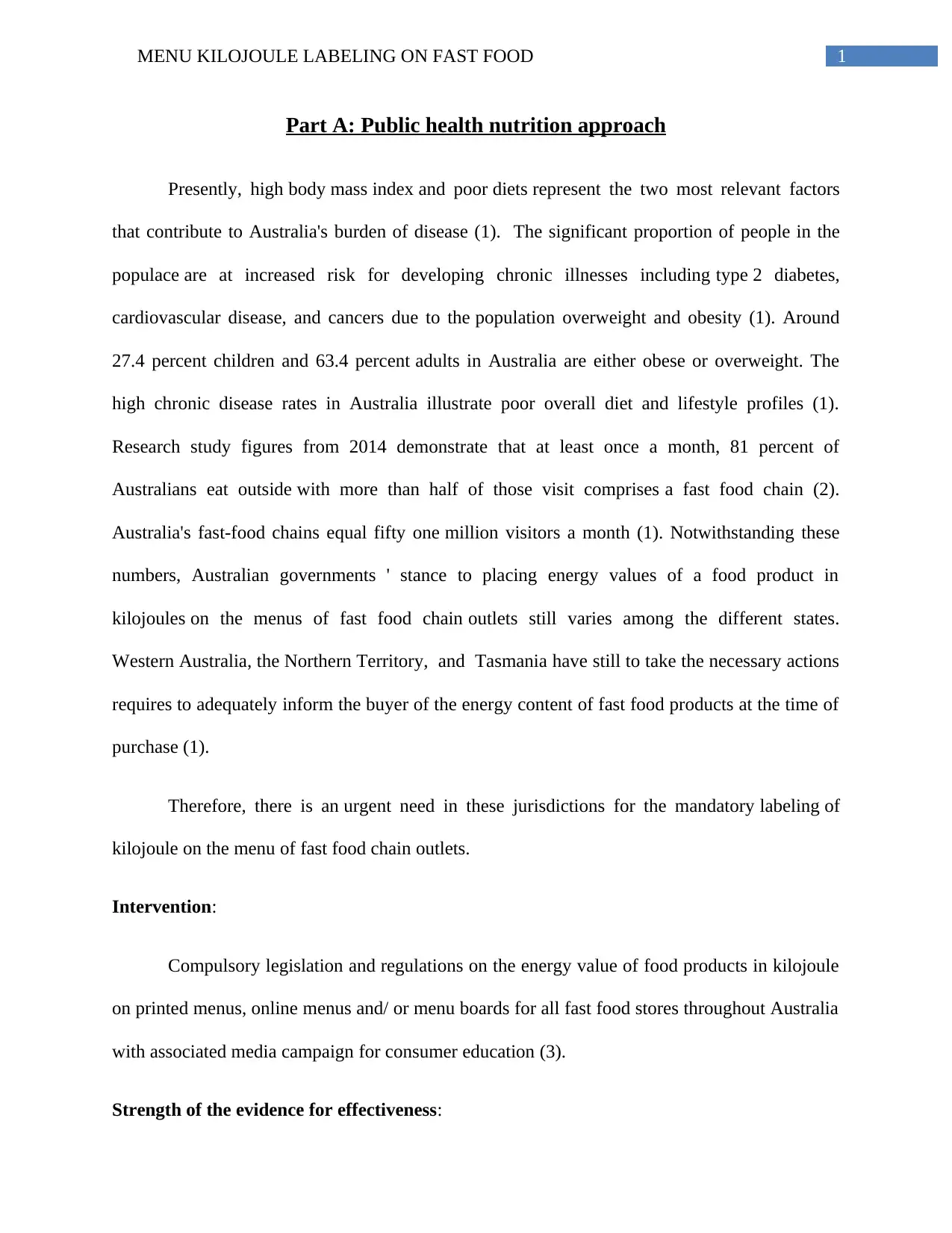
1MENU KILOJOULE LABELING ON FAST FOOD
Part A: Public health nutrition approach
Presently, high body mass index and poor diets represent the two most relevant factors
that contribute to Australia's burden of disease (1). The significant proportion of people in the
populace are at increased risk for developing chronic illnesses including type 2 diabetes,
cardiovascular disease, and cancers due to the population overweight and obesity (1). Around
27.4 percent children and 63.4 percent adults in Australia are either obese or overweight. The
high chronic disease rates in Australia illustrate poor overall diet and lifestyle profiles (1).
Research study figures from 2014 demonstrate that at least once a month, 81 percent of
Australians eat outside with more than half of those visit comprises a fast food chain (2).
Australia's fast-food chains equal fifty one million visitors a month (1). Notwithstanding these
numbers, Australian governments ' stance to placing energy values of a food product in
kilojoules on the menus of fast food chain outlets still varies among the different states.
Western Australia, the Northern Territory, and Tasmania have still to take the necessary actions
requires to adequately inform the buyer of the energy content of fast food products at the time of
purchase (1).
Therefore, there is an urgent need in these jurisdictions for the mandatory labeling of
kilojoule on the menu of fast food chain outlets.
Intervention:
Compulsory legislation and regulations on the energy value of food products in kilojoule
on printed menus, online menus and/ or menu boards for all fast food stores throughout Australia
with associated media campaign for consumer education (3).
Strength of the evidence for effectiveness:
Part A: Public health nutrition approach
Presently, high body mass index and poor diets represent the two most relevant factors
that contribute to Australia's burden of disease (1). The significant proportion of people in the
populace are at increased risk for developing chronic illnesses including type 2 diabetes,
cardiovascular disease, and cancers due to the population overweight and obesity (1). Around
27.4 percent children and 63.4 percent adults in Australia are either obese or overweight. The
high chronic disease rates in Australia illustrate poor overall diet and lifestyle profiles (1).
Research study figures from 2014 demonstrate that at least once a month, 81 percent of
Australians eat outside with more than half of those visit comprises a fast food chain (2).
Australia's fast-food chains equal fifty one million visitors a month (1). Notwithstanding these
numbers, Australian governments ' stance to placing energy values of a food product in
kilojoules on the menus of fast food chain outlets still varies among the different states.
Western Australia, the Northern Territory, and Tasmania have still to take the necessary actions
requires to adequately inform the buyer of the energy content of fast food products at the time of
purchase (1).
Therefore, there is an urgent need in these jurisdictions for the mandatory labeling of
kilojoule on the menu of fast food chain outlets.
Intervention:
Compulsory legislation and regulations on the energy value of food products in kilojoule
on printed menus, online menus and/ or menu boards for all fast food stores throughout Australia
with associated media campaign for consumer education (3).
Strength of the evidence for effectiveness:
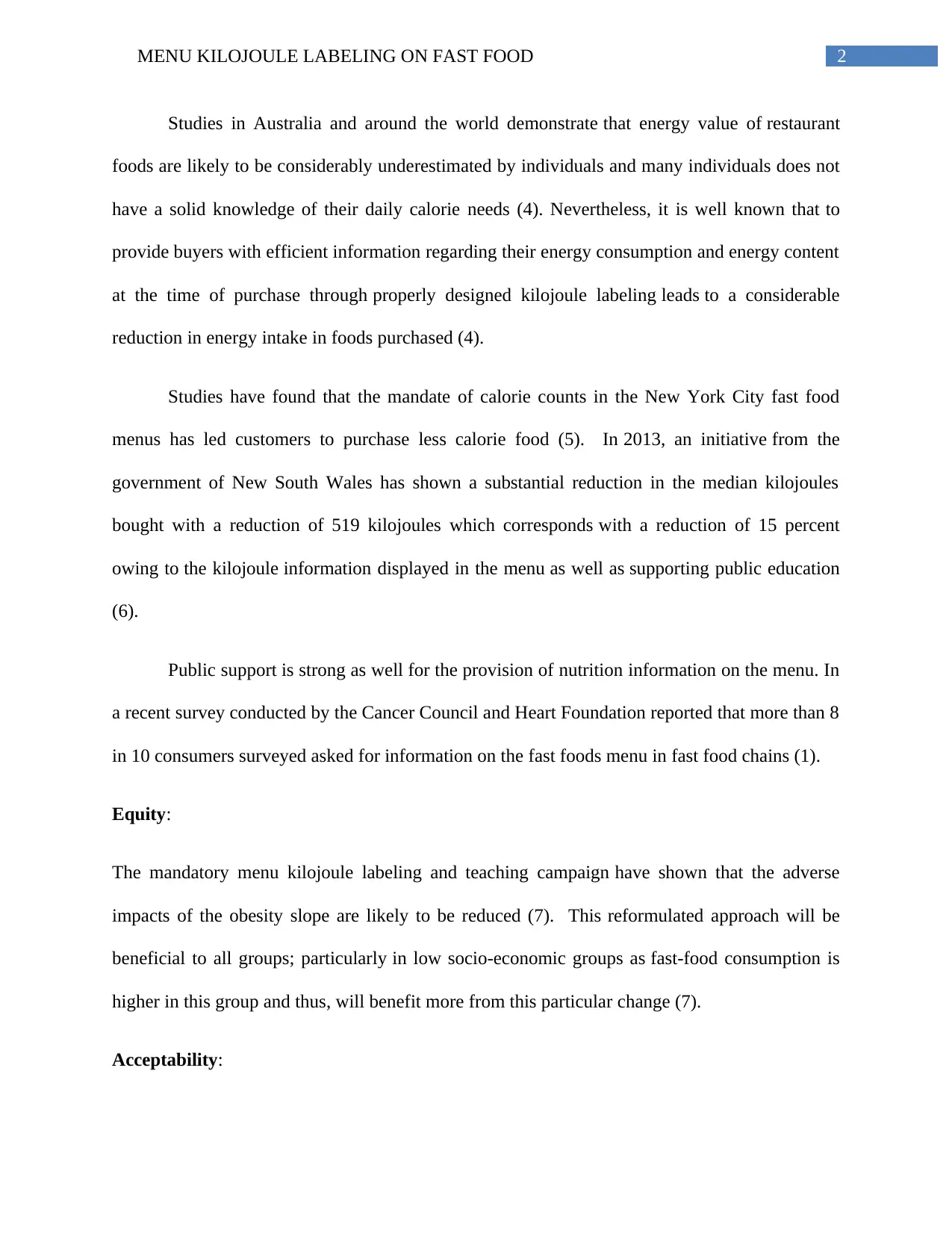
2MENU KILOJOULE LABELING ON FAST FOOD
Studies in Australia and around the world demonstrate that energy value of restaurant
foods are likely to be considerably underestimated by individuals and many individuals does not
have a solid knowledge of their daily calorie needs (4). Nevertheless, it is well known that to
provide buyers with efficient information regarding their energy consumption and energy content
at the time of purchase through properly designed kilojoule labeling leads to a considerable
reduction in energy intake in foods purchased (4).
Studies have found that the mandate of calorie counts in the New York City fast food
menus has led customers to purchase less calorie food (5). In 2013, an initiative from the
government of New South Wales has shown a substantial reduction in the median kilojoules
bought with a reduction of 519 kilojoules which corresponds with a reduction of 15 percent
owing to the kilojoule information displayed in the menu as well as supporting public education
(6).
Public support is strong as well for the provision of nutrition information on the menu. In
a recent survey conducted by the Cancer Council and Heart Foundation reported that more than 8
in 10 consumers surveyed asked for information on the fast foods menu in fast food chains (1).
Equity:
The mandatory menu kilojoule labeling and teaching campaign have shown that the adverse
impacts of the obesity slope are likely to be reduced (7). This reformulated approach will be
beneficial to all groups; particularly in low socio-economic groups as fast-food consumption is
higher in this group and thus, will benefit more from this particular change (7).
Acceptability:
Studies in Australia and around the world demonstrate that energy value of restaurant
foods are likely to be considerably underestimated by individuals and many individuals does not
have a solid knowledge of their daily calorie needs (4). Nevertheless, it is well known that to
provide buyers with efficient information regarding their energy consumption and energy content
at the time of purchase through properly designed kilojoule labeling leads to a considerable
reduction in energy intake in foods purchased (4).
Studies have found that the mandate of calorie counts in the New York City fast food
menus has led customers to purchase less calorie food (5). In 2013, an initiative from the
government of New South Wales has shown a substantial reduction in the median kilojoules
bought with a reduction of 519 kilojoules which corresponds with a reduction of 15 percent
owing to the kilojoule information displayed in the menu as well as supporting public education
(6).
Public support is strong as well for the provision of nutrition information on the menu. In
a recent survey conducted by the Cancer Council and Heart Foundation reported that more than 8
in 10 consumers surveyed asked for information on the fast foods menu in fast food chains (1).
Equity:
The mandatory menu kilojoule labeling and teaching campaign have shown that the adverse
impacts of the obesity slope are likely to be reduced (7). This reformulated approach will be
beneficial to all groups; particularly in low socio-economic groups as fast-food consumption is
higher in this group and thus, will benefit more from this particular change (7).
Acceptability:
⊘ This is a preview!⊘
Do you want full access?
Subscribe today to unlock all pages.

Trusted by 1+ million students worldwide

3MENU KILOJOULE LABELING ON FAST FOOD
Government: Menu labeling for kilojoule in Australia have already been implemented at the 5
jurisdictions which are Queensland, New South Wales, South Australia, ACT, and Victoria (3).
Industry: Fast food industry bears certain costs relating to compliance and implementation, but in
five jurisdictions mentioned above acceptability has increased when implementing (3).
Public: Public support for this intervention will likely be strong as evidenced by the survey
completed by the New South Wales government stated in the above section (3).
Feasibility or sustainability:
This intervention has been carried out in five Australian and several international jurisdictions
already. The regulatory nature of the intervention gives this intervention a high sustainability (3).
Part B: Critical appraisal of supporting evidence
Study 1 – “What types of nutrition menu labelling lead consumers to select less energy-dense
fast food? An experimental study” (8)
This study by Morley et al. (2013) examined the possibility of selecting energy-dense fast
foods by including kilojoule labeling, alone or with other nutritional information on menus.
Their study used an experimental design between subjects to test five conditions for menu
labeling. A web based research design was used to reveal adults to a choice of one of five menu
boards, selected randomly for the evening meal. There were 1294 adults respondents
aged between 18 to 49 years who were from Victoria, Australia. Meals selected for non-labeling
conditions has the maximum mean amount of energy and foods with a mean energy intake of
about 500 kJ (120 kcal) were considerably lower than for those looking at kilojoule and kilojoule
plus traffic light data. Participants most frequently made their choices using traffic light labels
Government: Menu labeling for kilojoule in Australia have already been implemented at the 5
jurisdictions which are Queensland, New South Wales, South Australia, ACT, and Victoria (3).
Industry: Fast food industry bears certain costs relating to compliance and implementation, but in
five jurisdictions mentioned above acceptability has increased when implementing (3).
Public: Public support for this intervention will likely be strong as evidenced by the survey
completed by the New South Wales government stated in the above section (3).
Feasibility or sustainability:
This intervention has been carried out in five Australian and several international jurisdictions
already. The regulatory nature of the intervention gives this intervention a high sustainability (3).
Part B: Critical appraisal of supporting evidence
Study 1 – “What types of nutrition menu labelling lead consumers to select less energy-dense
fast food? An experimental study” (8)
This study by Morley et al. (2013) examined the possibility of selecting energy-dense fast
foods by including kilojoule labeling, alone or with other nutritional information on menus.
Their study used an experimental design between subjects to test five conditions for menu
labeling. A web based research design was used to reveal adults to a choice of one of five menu
boards, selected randomly for the evening meal. There were 1294 adults respondents
aged between 18 to 49 years who were from Victoria, Australia. Meals selected for non-labeling
conditions has the maximum mean amount of energy and foods with a mean energy intake of
about 500 kJ (120 kcal) were considerably lower than for those looking at kilojoule and kilojoule
plus traffic light data. Participants most frequently made their choices using traffic light labels
Paraphrase This Document
Need a fresh take? Get an instant paraphrase of this document with our AI Paraphraser
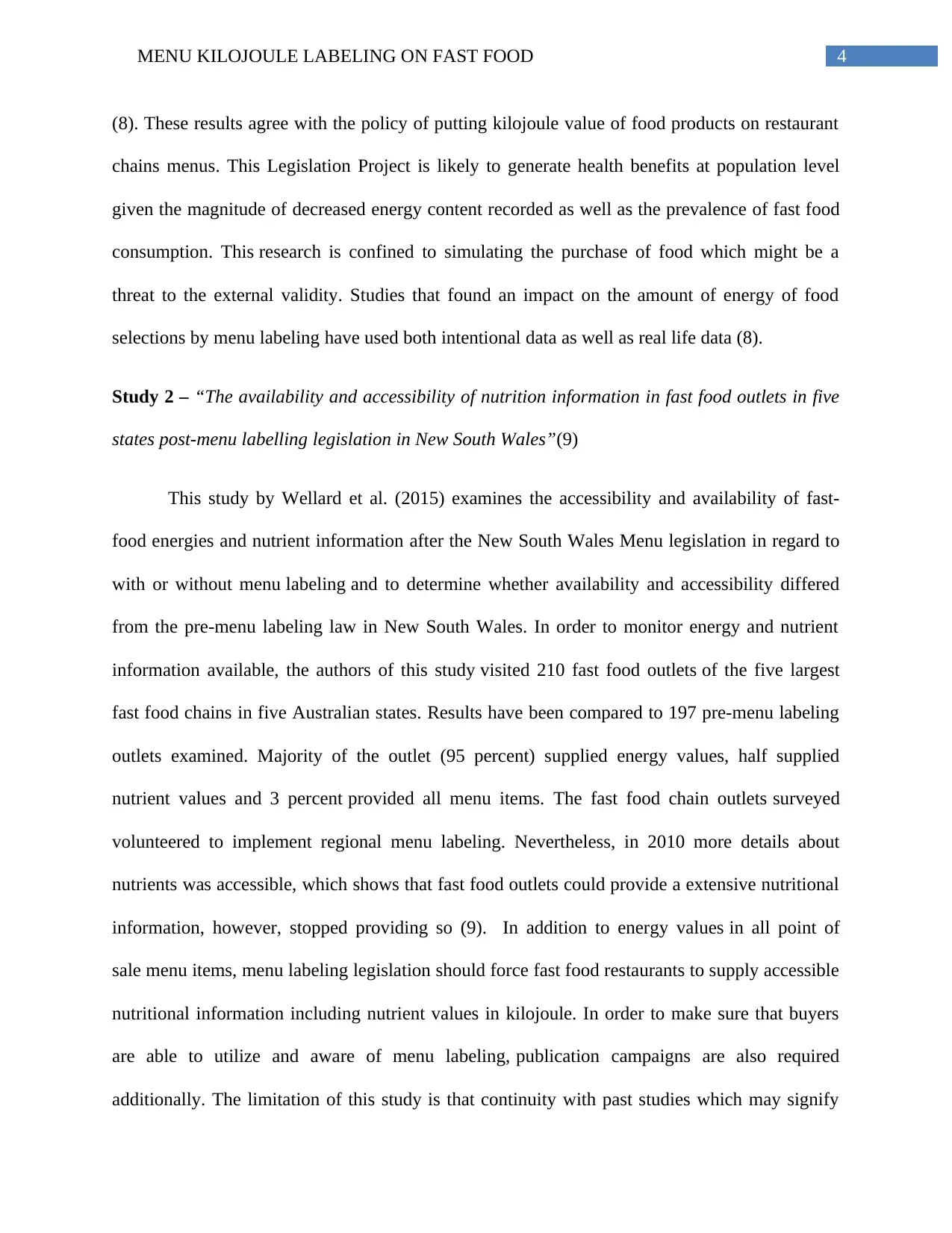
4MENU KILOJOULE LABELING ON FAST FOOD
(8). These results agree with the policy of putting kilojoule value of food products on restaurant
chains menus. This Legislation Project is likely to generate health benefits at population level
given the magnitude of decreased energy content recorded as well as the prevalence of fast food
consumption. This research is confined to simulating the purchase of food which might be a
threat to the external validity. Studies that found an impact on the amount of energy of food
selections by menu labeling have used both intentional data as well as real life data (8).
Study 2 – “The availability and accessibility of nutrition information in fast food outlets in five
states post‐menu labelling legislation in New South Wales”(9)
This study by Wellard et al. (2015) examines the accessibility and availability of fast-
food energies and nutrient information after the New South Wales Menu legislation in regard to
with or without menu labeling and to determine whether availability and accessibility differed
from the pre-menu labeling law in New South Wales. In order to monitor energy and nutrient
information available, the authors of this study visited 210 fast food outlets of the five largest
fast food chains in five Australian states. Results have been compared to 197 pre-menu labeling
outlets examined. Majority of the outlet (95 percent) supplied energy values, half supplied
nutrient values and 3 percent provided all menu items. The fast food chain outlets surveyed
volunteered to implement regional menu labeling. Nevertheless, in 2010 more details about
nutrients was accessible, which shows that fast food outlets could provide a extensive nutritional
information, however, stopped providing so (9). In addition to energy values in all point of
sale menu items, menu labeling legislation should force fast food restaurants to supply accessible
nutritional information including nutrient values in kilojoule. In order to make sure that buyers
are able to utilize and aware of menu labeling, publication campaigns are also required
additionally. The limitation of this study is that continuity with past studies which may signify
(8). These results agree with the policy of putting kilojoule value of food products on restaurant
chains menus. This Legislation Project is likely to generate health benefits at population level
given the magnitude of decreased energy content recorded as well as the prevalence of fast food
consumption. This research is confined to simulating the purchase of food which might be a
threat to the external validity. Studies that found an impact on the amount of energy of food
selections by menu labeling have used both intentional data as well as real life data (8).
Study 2 – “The availability and accessibility of nutrition information in fast food outlets in five
states post‐menu labelling legislation in New South Wales”(9)
This study by Wellard et al. (2015) examines the accessibility and availability of fast-
food energies and nutrient information after the New South Wales Menu legislation in regard to
with or without menu labeling and to determine whether availability and accessibility differed
from the pre-menu labeling law in New South Wales. In order to monitor energy and nutrient
information available, the authors of this study visited 210 fast food outlets of the five largest
fast food chains in five Australian states. Results have been compared to 197 pre-menu labeling
outlets examined. Majority of the outlet (95 percent) supplied energy values, half supplied
nutrient values and 3 percent provided all menu items. The fast food chain outlets surveyed
volunteered to implement regional menu labeling. Nevertheless, in 2010 more details about
nutrients was accessible, which shows that fast food outlets could provide a extensive nutritional
information, however, stopped providing so (9). In addition to energy values in all point of
sale menu items, menu labeling legislation should force fast food restaurants to supply accessible
nutritional information including nutrient values in kilojoule. In order to make sure that buyers
are able to utilize and aware of menu labeling, publication campaigns are also required
additionally. The limitation of this study is that continuity with past studies which may signify
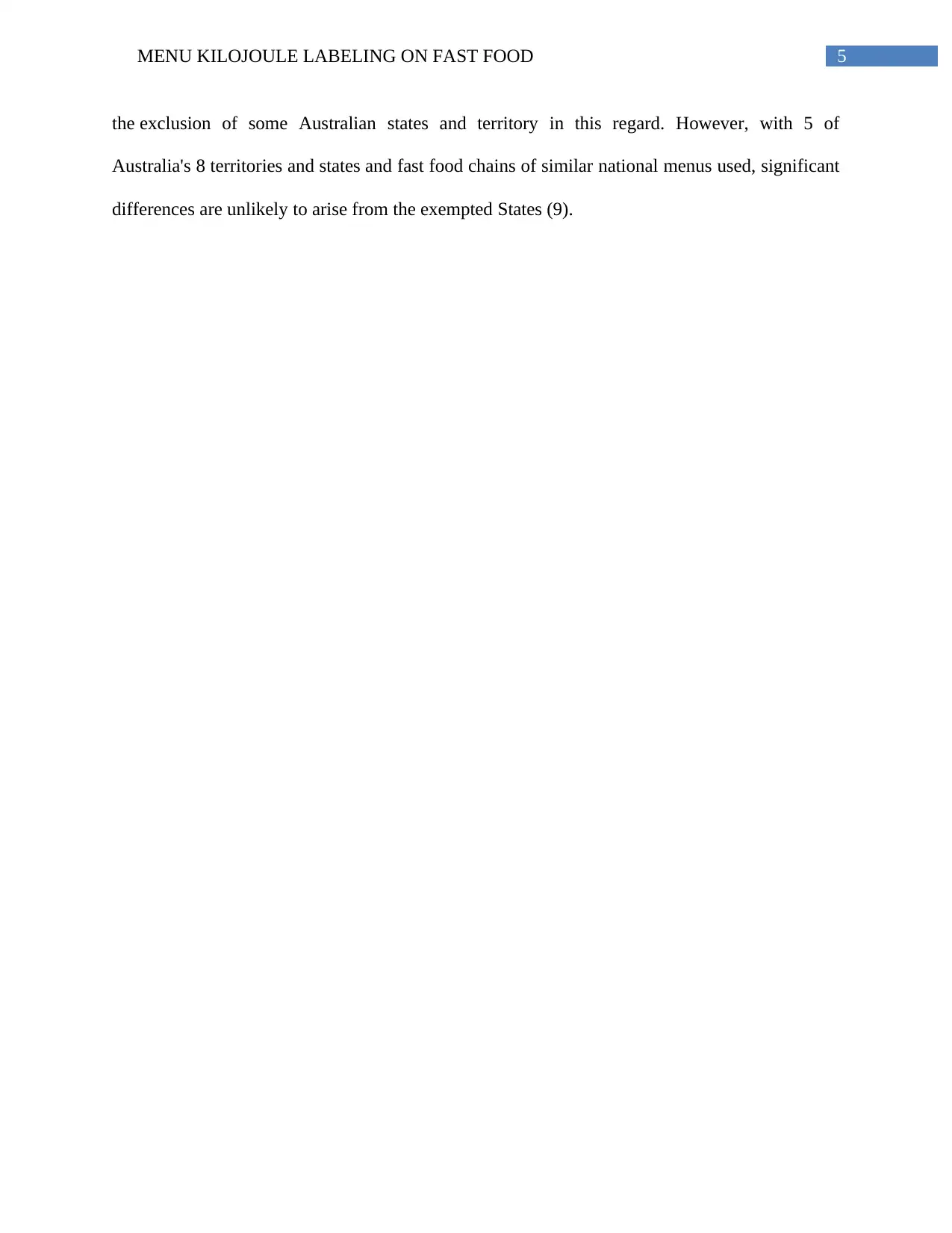
5MENU KILOJOULE LABELING ON FAST FOOD
the exclusion of some Australian states and territory in this regard. However, with 5 of
Australia's 8 territories and states and fast food chains of similar national menus used, significant
differences are unlikely to arise from the exempted States (9).
the exclusion of some Australian states and territory in this regard. However, with 5 of
Australia's 8 territories and states and fast food chains of similar national menus used, significant
differences are unlikely to arise from the exempted States (9).
⊘ This is a preview!⊘
Do you want full access?
Subscribe today to unlock all pages.

Trusted by 1+ million students worldwide
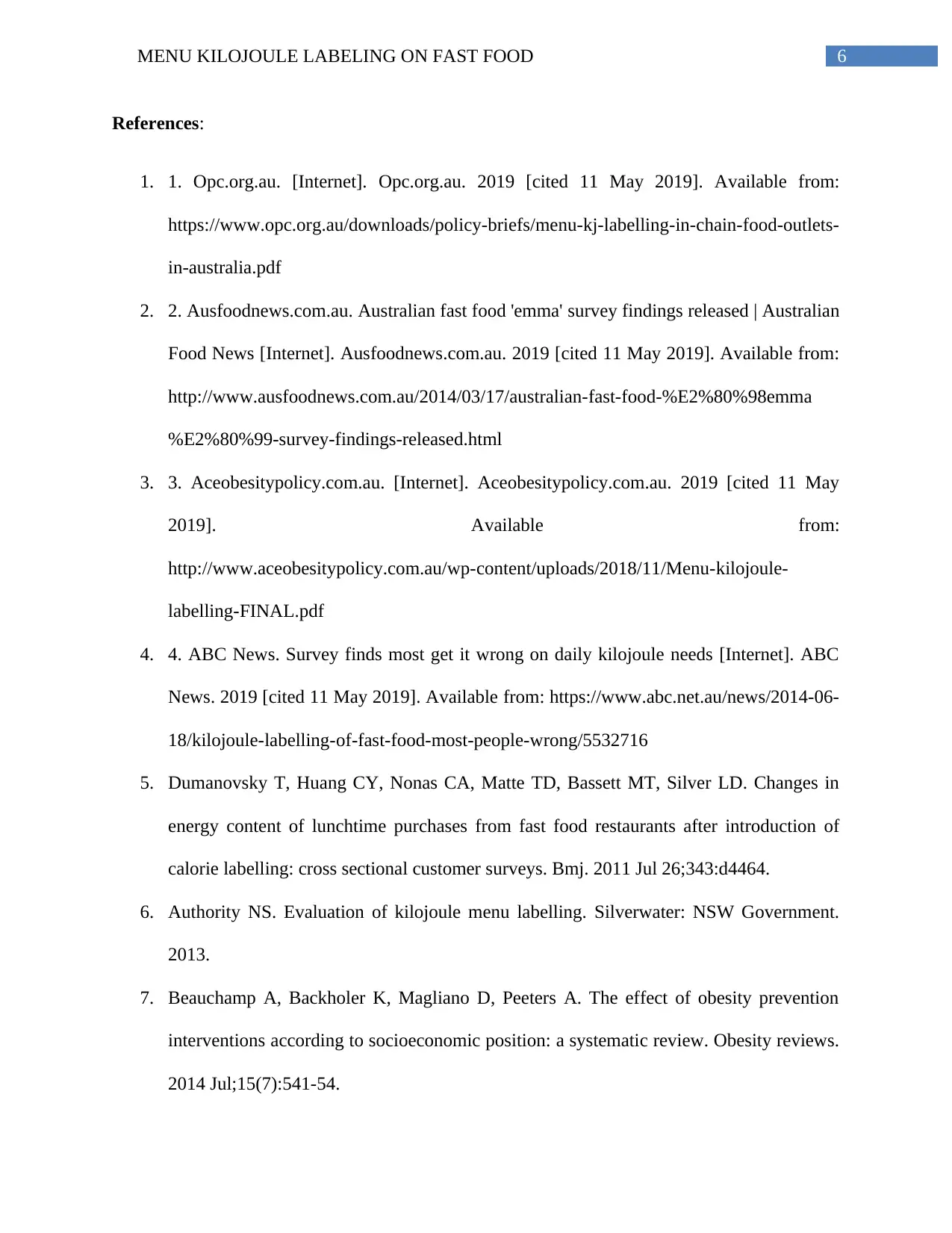
6MENU KILOJOULE LABELING ON FAST FOOD
References:
1. 1. Opc.org.au. [Internet]. Opc.org.au. 2019 [cited 11 May 2019]. Available from:
https://www.opc.org.au/downloads/policy-briefs/menu-kj-labelling-in-chain-food-outlets-
in-australia.pdf
2. 2. Ausfoodnews.com.au. Australian fast food 'emma' survey findings released | Australian
Food News [Internet]. Ausfoodnews.com.au. 2019 [cited 11 May 2019]. Available from:
http://www.ausfoodnews.com.au/2014/03/17/australian-fast-food-%E2%80%98emma
%E2%80%99-survey-findings-released.html
3. 3. Aceobesitypolicy.com.au. [Internet]. Aceobesitypolicy.com.au. 2019 [cited 11 May
2019]. Available from:
http://www.aceobesitypolicy.com.au/wp-content/uploads/2018/11/Menu-kilojoule-
labelling-FINAL.pdf
4. 4. ABC News. Survey finds most get it wrong on daily kilojoule needs [Internet]. ABC
News. 2019 [cited 11 May 2019]. Available from: https://www.abc.net.au/news/2014-06-
18/kilojoule-labelling-of-fast-food-most-people-wrong/5532716
5. Dumanovsky T, Huang CY, Nonas CA, Matte TD, Bassett MT, Silver LD. Changes in
energy content of lunchtime purchases from fast food restaurants after introduction of
calorie labelling: cross sectional customer surveys. Bmj. 2011 Jul 26;343:d4464.
6. Authority NS. Evaluation of kilojoule menu labelling. Silverwater: NSW Government.
2013.
7. Beauchamp A, Backholer K, Magliano D, Peeters A. The effect of obesity prevention
interventions according to socioeconomic position: a systematic review. Obesity reviews.
2014 Jul;15(7):541-54.
References:
1. 1. Opc.org.au. [Internet]. Opc.org.au. 2019 [cited 11 May 2019]. Available from:
https://www.opc.org.au/downloads/policy-briefs/menu-kj-labelling-in-chain-food-outlets-
in-australia.pdf
2. 2. Ausfoodnews.com.au. Australian fast food 'emma' survey findings released | Australian
Food News [Internet]. Ausfoodnews.com.au. 2019 [cited 11 May 2019]. Available from:
http://www.ausfoodnews.com.au/2014/03/17/australian-fast-food-%E2%80%98emma
%E2%80%99-survey-findings-released.html
3. 3. Aceobesitypolicy.com.au. [Internet]. Aceobesitypolicy.com.au. 2019 [cited 11 May
2019]. Available from:
http://www.aceobesitypolicy.com.au/wp-content/uploads/2018/11/Menu-kilojoule-
labelling-FINAL.pdf
4. 4. ABC News. Survey finds most get it wrong on daily kilojoule needs [Internet]. ABC
News. 2019 [cited 11 May 2019]. Available from: https://www.abc.net.au/news/2014-06-
18/kilojoule-labelling-of-fast-food-most-people-wrong/5532716
5. Dumanovsky T, Huang CY, Nonas CA, Matte TD, Bassett MT, Silver LD. Changes in
energy content of lunchtime purchases from fast food restaurants after introduction of
calorie labelling: cross sectional customer surveys. Bmj. 2011 Jul 26;343:d4464.
6. Authority NS. Evaluation of kilojoule menu labelling. Silverwater: NSW Government.
2013.
7. Beauchamp A, Backholer K, Magliano D, Peeters A. The effect of obesity prevention
interventions according to socioeconomic position: a systematic review. Obesity reviews.
2014 Jul;15(7):541-54.
Paraphrase This Document
Need a fresh take? Get an instant paraphrase of this document with our AI Paraphraser
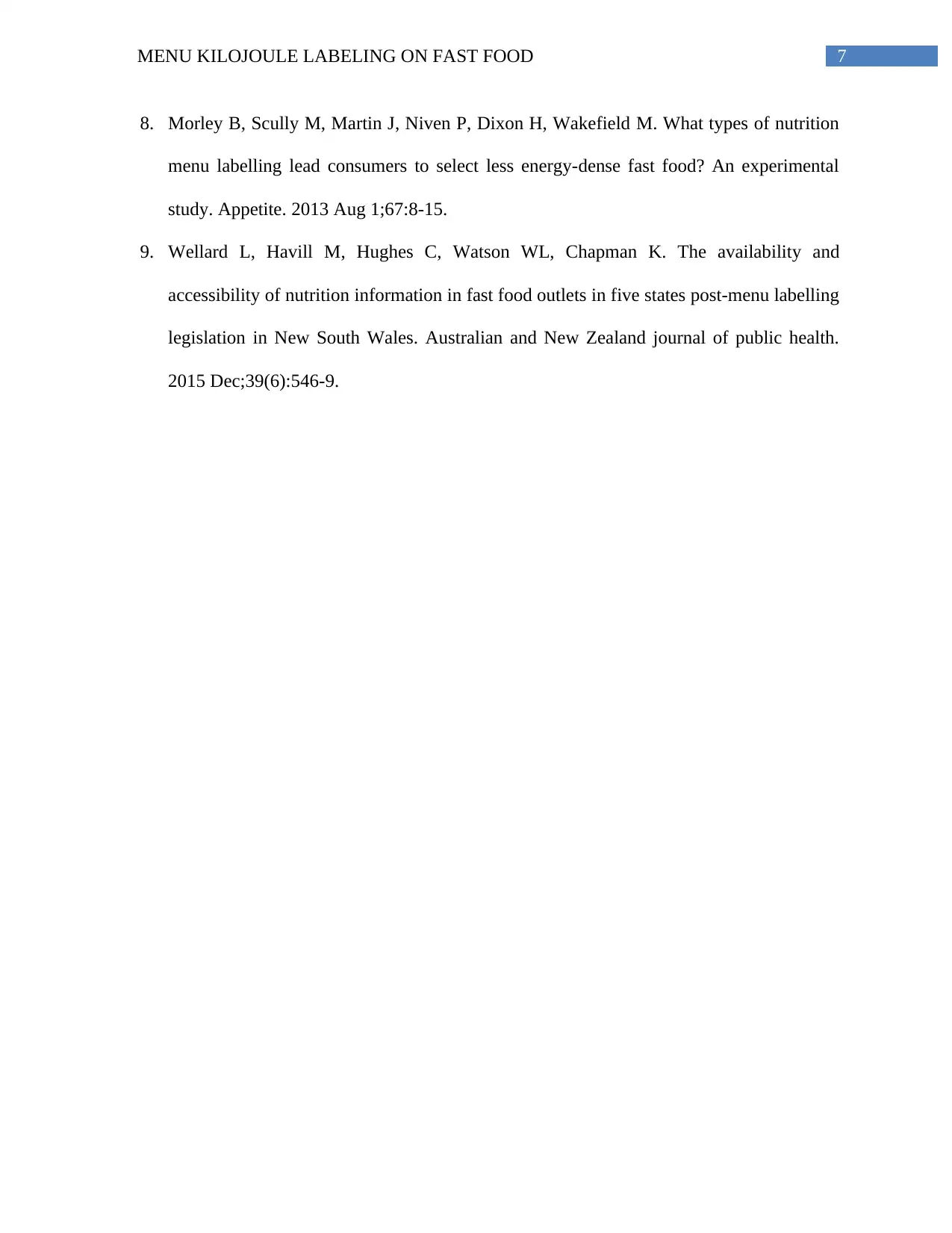
7MENU KILOJOULE LABELING ON FAST FOOD
8. Morley B, Scully M, Martin J, Niven P, Dixon H, Wakefield M. What types of nutrition
menu labelling lead consumers to select less energy-dense fast food? An experimental
study. Appetite. 2013 Aug 1;67:8-15.
9. Wellard L, Havill M, Hughes C, Watson WL, Chapman K. The availability and
accessibility of nutrition information in fast food outlets in five states post‐menu labelling
legislation in New South Wales. Australian and New Zealand journal of public health.
2015 Dec;39(6):546-9.
8. Morley B, Scully M, Martin J, Niven P, Dixon H, Wakefield M. What types of nutrition
menu labelling lead consumers to select less energy-dense fast food? An experimental
study. Appetite. 2013 Aug 1;67:8-15.
9. Wellard L, Havill M, Hughes C, Watson WL, Chapman K. The availability and
accessibility of nutrition information in fast food outlets in five states post‐menu labelling
legislation in New South Wales. Australian and New Zealand journal of public health.
2015 Dec;39(6):546-9.
1 out of 8
Related Documents
Your All-in-One AI-Powered Toolkit for Academic Success.
+13062052269
info@desklib.com
Available 24*7 on WhatsApp / Email
![[object Object]](/_next/static/media/star-bottom.7253800d.svg)
Unlock your academic potential
Copyright © 2020–2025 A2Z Services. All Rights Reserved. Developed and managed by ZUCOL.





